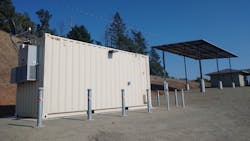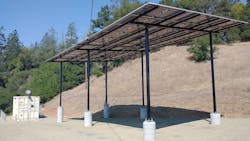Innovation in Wildfire Mitigation: PG&E Deploys Its First 100% Renewable Remote Grid
Leaders from Pacific Gas and Electric Company, Pepperwood Foundation, BoxPower Inc., Sonoma Clean Power, Franklin Energy, and the California Public Utilities Commission gathered with regional, state and federal stakeholders at Pepperwood Preserve in Sonoma County to commemorate the first fully renewable remote grid deployed in PG&E’s growing fleet of standalone power systems.
As described in PG&E’s Wildfire Mitigation Plan, remote grids provide utility service using standalone local energy resources. Throughout PG&E's 70,000-square-mile service area, there are remote customers served via long electric distribution lines that traverse high fire-risk areas. Replacing these distribution lines with a remote grid is an innovative option that can cost-effectively meet customer needs and reduce fire ignition risk.
The fully renewable remote grid at Pepperwood replaces 0.7 miles of overhead distribution line, eliminating the associated wildfire risk. The location was identified, designed, and deployed as part of PG&E’s system hardening work, which prioritizes powerlines for system hardening based on elevated wildfire risk and geographic considerations. In addition to remote grids, PG&E’s system hardening efforts include undergrounding, installing stronger and more resilient poles, and replacing bare power lines with larger, covered lines.
“Remote grids demonstrate PG&E’s ability to be tenacious and nimble in delivering customer solutions to stop catastrophic wildfires,” said Joe Bentley, Senior Vice President, Electric Engineering, PG&E. “The close collaboration between PG&E and our project partners on the remote grid at Pepperwood is a prime example of how we can innovate to serve local needs as we carry out critical wildfire mitigation work.”
Set in the Mayacamas Mountains within the traditional homeland of the Wappo people, Pepperwood Preserve is a living laboratory for crafting climate and wildfire solutions grounded in conservation science. The 3,200-acre property is an important refuge for more than 900 species of native plants and wildlife and was directly impacted by both the Tubbs and Kincade Fires. Pepperwood is a hub for climate monitoring, applied research, science education, and wildfire resilience demonstration projects, such as the now extensive ALERTWildfire camera network. The new remote grid will power Pepperwood’s Bechtel House, which houses overnight visitors.
“Pepperwood regularly hosts researchers, policy-makers and philanthropists from around the world to learn about wildfire resilience innovation. We are delighted to partner with our clean energy leaders on PG&E’s first fully renewable remote grid in California,” says Lisa Micheli, President and CEO, Pepperwood Foundation. “As a research and education institution dedicated to showcasing best practices, we look forward to benefiting from this clean energy source and presenting it to visitors from near and far as part of a new wave of remote energy solutions.”
Local Energy Resources to Meet Local Needs
Achieving a 100% renewable remote grid at Pepperwood required a high level of collaboration between many project partners. From the start, Pepperwood and Sonoma Clean Power (SCP) engaged with PG&E to vet the potential for a remote grid without any fuel-based backup generation. SCP performed an upfront energy audit in addition to consulting at key project milestones that helped establish how a solar-plus-storage system could be tailored to the customer needs at Pepperwood’s Bechtel House.
Sonoma Clean Power’s CEO, Geof Syphers, said “This 100% renewable off-grid system was only possible because of the close collaboration between Pepperwood Preserve, PG&E and Sonoma Clean Power, and it creates a new model for cutting ratepayer costs and fire risks while achieving California’s renewable policy goals.”
Under contract to PG&E, BoxPower designed, built, and will maintain the remote grid at Pepperwood. The system includes a BoxPower SolarContainer featuring a battery energy storage system that was prefabricated at the BoxPower facility in Grass Valley before being transported to the site. The generation source is a canopy solar array. Construction of the system was completed in less than eight weeks and followed by a rigorous testing and commissioning process.
"We are proud to have designed and built not only PG&E's first remote grid, but also their first 100% renewable standalone power system,” said BoxPower Co-Founder and Chief Financial Officer Anderson Barkow. “Reducing wildfire risk in areas like Pepperwood is critical for the surrounding communities and the native wildlife that collectively call this place home. This cost-effective approach to wildfire mitigation provides an excellent blueprint for implementation across potentially hundreds of remote sites.”
Under contract to PG&E, project partner Franklin Energy installed a targeted set of energy efficiency improvements at the house that are expected to reduce the possibility of outages during periods of low solar generation. Franklin Energy’s end-to-end scope included detailed energy modeling of the proposed efficiency improvements that in turn informed the remote grid system design. The new energy-efficient insulation, HVAC, and similar improvements have already contributed to reduced energy usage and increased comfort at the house.
“Efficiency and renewable power go hand in hand,” said Brett Bishop, Technical Advisor for Franklin Energy. “It was rewarding for our team to put this synergy into practice while showing it can improve the lived experience at the house as well.”
Expansion of Remote Grids in the 2020s
The remote grid at Pepperwood will be PG&E’s fifth operational remote grid since 2021.
Collectively, PG&E’s five remote grids enable 10 customers to continue receiving safe, reliable, affordable, and low-carbon energy while removing approximately five miles of overhead distribution electric lines at the grid edge in high fire-threat areas. PG&E has identified many locations where remote grids may be the most effective way of reducing wildfire risk and improving electric reliability, with additional sites either in development or being assessed in Madera, Shasta, and Tehama counties, among others.
PG&E plans to scale its remote grid fleet to dozens of systems over the next several years, leveraging Richmond, Calif.-based New Sun Road’s Stellar Microgrid OSTM as the remote monitoring and control platform. The Stellar platform enables PG&E to monitor and control remote grids via satellite and cellular connectivity, with capabilities for remote performance management, safety diagnostics, alarms, reporting, and automated refueling notifications. Remote grids also feature an integrated fire suppression system to protect the hardware and facility.
For more information and to watch a video about PG&E’s remote grid program visit pge.com/remotegrids

